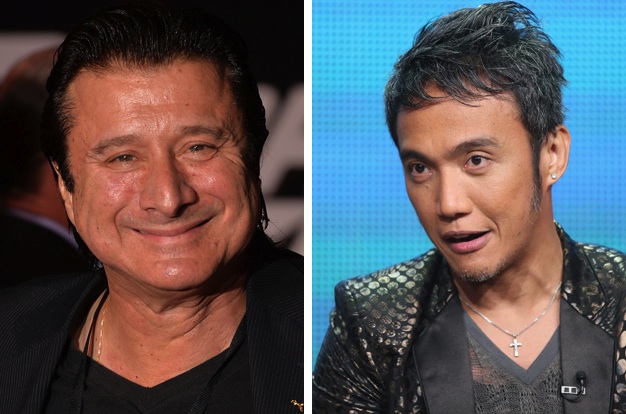What gives a musical group its identity? Is it the name on the poster or the people on the stage ?
What would it be like to see all the original band members of our favorite bands on stage with the same magic and energy they had in their prime ? The chances of that happening is a lot like lightening striking twice in the same place. Breakups, death, and life in general just happens, none of us are immune to it.
Two years ago MORRISSEY (given the bad blood between and the rest of the SMITHS) told Billboard: “I don’t know a single person who wants a Smiths reunion! There aren’t any bands I like to see again because your memory of them is how they were in their prime or at their best or at their most desperate, and you look to them to be someone that they no longer are.”
REM performed together for over 30 years but called it quits in 2011. In 2014 frontman Michael Stipe appeared on US television and claimed a reunion “will never happen… There’s no point. I love those guys very much and I respect them hugely as musicians and as songwriters and everything but I just don’t want to do that thing that people do…I despise nostalgia. I’m not good at looking back”.
Geoffrey Hines of the Smithsonian asked if there was any chance of Gramm returning to FOREIGNER for some special shows to celebrate the band’s fortieth anniversary, Jones said: “Well, it’s quite possible. We’ve actually been talking about it. I’m not at a point where I can say it’s definitely gonna happen, but we’re all working on trying to make it happen. So it’s kind of exciting. And hopefully it’ll be feasible and possible to pull it off next year.” He continued: “Lou and I have communicated, and, of course, we got together when were beneficiaries of the Songwriters Hall Of Fame award [in 2013]. And since then, we’ve kept up sort of a loose communication, as I have actually also with Ian McDonald [rhythm guitar], Al Greenwood [keyboards], Dennis Elliott [drums] and Rick Wills [bass]. So, yeah, as I say, we’re in the early stages, but we’re trying to put something together to commemorate… It’s scary when I say… forty years. [Laughs]”
Former JOURNEY lead singer Steve Perry’s long-awaited return to the stage late last month has naturally fueled speculation as to whether the vocalist would ever reunite with his former band. But in a new interview, he is once again quick to both dash those rumors and pay his respects to the man who has held that position for over seven years now. Speaking with Fan Asylum, Perry confirms that “there is no reunion” plan in the works between him and Journey. Asked what he thought of current singer Arnel Pineda‘s respectful and presumably not literal offer to step aside so that he could have his old job back, Perry says, “I don’t know who or what would make Arnel want to say such a thing. He’s their lead singer and I wish him all the best.”
As the ROLLING STONES tour North America this summer, only three of the original five members will still be in the band. But those three, most people would agree, are the essential core: singer-songwriter Mick Jagger, guitarist-songwriter Keith Richards and drummer Charlie Watts. The second guitar slot has changed over twice—from Brian Jones to Mick Taylor to Ron Wood–and retired bassist Bill Wyman has been replaced by non-member Darryl Jones. But few would dispute that this is the genuine article.
The BEACH BOYS are also touring, but only one of the original members will be on hand: lead singer Mike Love. Two of the original five (brothers Carl and Dennis Wilson) are dead, but the other two surviving members (Al Jardine and third brother Brian Wilson) will be touring this month under the Brian Wilson banner. Love will be joined by another longtime Beach Boy, Bruce Johnston, but Wilson will also have another former member, Blondie Chaplin.
We usually link the identity of a band to its lead singer and/or chief songwriter. As long as that person is still around, we’re willing to accept a new drummer or new keyboardist. This may not be fair, but it’s true. Keith Moon and Tiki Fulwood were great drummers before they died, but we’re willing to accept the WHO and PARLIAMENT-FUNKADELIC without Moon or Fulwood as long as Roger Daltrey and George Clinton are on hand. But once that key voice is gone, we usually lose interest in the band.
John Lennon, George Harrison and Ringo Starr might have been able to carry on as the BEATLES after Paul McCartney quit, but it seems unlikely that audiences would have accepted Harrison and Starr as the Beatles if both Lennon and McCartney had left.
It would have been foolish for Dave Grohl and Krist Novoselic to go on as NIRVANA after Kurt Cobain committed suicide in 1994. Wisely, they didn’t, and Grohl launched a new band, the Foo Fighters, with its own identity.
But it’s not impossible for a band to survive the loss of a lead-singer-songwriter if they handle it properly. Witness the quick sellouts for the farewell concerts by the GRATEFUL DEAD this summer. No one disputes that Jerry Garcia, the singer-guitarist who died in 1995, was the band’s linchpin. But fans recognize that the band was not only a musical democracy but also the binding glue of a community larger than any one person.
The TEMPTATIONS, another Motown group, handled personnel turnover like a baseball team. The lead-singer role was passed from Al Bryant to Eddie Kendricks to David Ruffin to Dennis Edwards, but it always sounded like the Temptations thanks to the gospel-based harmonies and the Motown songwriting/production system. Otis Williams, the baritone harmonizer, wasn’t a lead singer but he was the organizational leader who guided the group through all its changes.
FLETTWOOD MAC also handled changing personnel smoothly, morphing from a British blues band led by Peter Green, Jeremy Spencer and Danny Kirwan to a California pop band led by Stevie Nicks, Lindsey Buckingham and Christine McVie. It worked only because the unchanging core—drummer Mick Fleetwood and bassist John McVie, who gave the band its name—had a distinctive sound and a vision of what the band should be. Sometimes a strong vision can be as effective as a great talent in keeping a group relevant. Williams and Fleetwood kept their bands alive by recognizing that there are always talented singers out there if you have the good taste to identify them and the sagacity to link the new to the old.
Fiddler Tammy Rogers has done something similar with the great country band the STEEL DRIVERS. Two gifted co-writers, Chris Stapleton and Mike Henderson, co-founded the group in 2008, looking to return bluegrass to its unacknowledged roots in the blues and honky-tonk with songs such as “Drinkin’ Dark Whiskey (Tellin’ White Lies)” and “The Blue Side of the Mountain (Where the Sun Don’t Ever Shine).” The son of a Kentucky coal miner, Stapleton possessed a deep, baritone growl that gave these songs an intimidating aggression, reinforced by the slashing melodic lines from Henderson’s mandolin and Rogers’ fiddle. It was unlike anything else in bluegrass. But after two Grammy-nominated albums and an on-screen appearance in the Robert Duvall movie Get Low with the SteelDrivers, Stapleton realized he could make more money staying home in Nashville with his family writing hit songs for the likes of Kenny Chesney, George Strait, Luke Bryan and Miranda Lambert than he could touring the bluegrass circuit. So he quit in 2010, followed by Henderson in 2011. But Rogers knew the SteelDrivers had a signature sound that shouldn’t be abandoned. She convinced banjoist Richard Bailey and bassist Mike Fleming to stay in the band, and they replaced Stapleton with the sound-alike Gary Nichols and Henderson with picker Ben Truitt. They even convinced Stapleton and Henderson to keep writing songs for the band. The result is an unlikely success story for a band that has lost its lead singer.
10 bands that still have all their original members:
Aerosmith
U2
ZZ Top
Poison
Kings X
Motley Crew
Twisted Sister
Lobos
Fall Out Boy
Triumph
Flash from the past:

